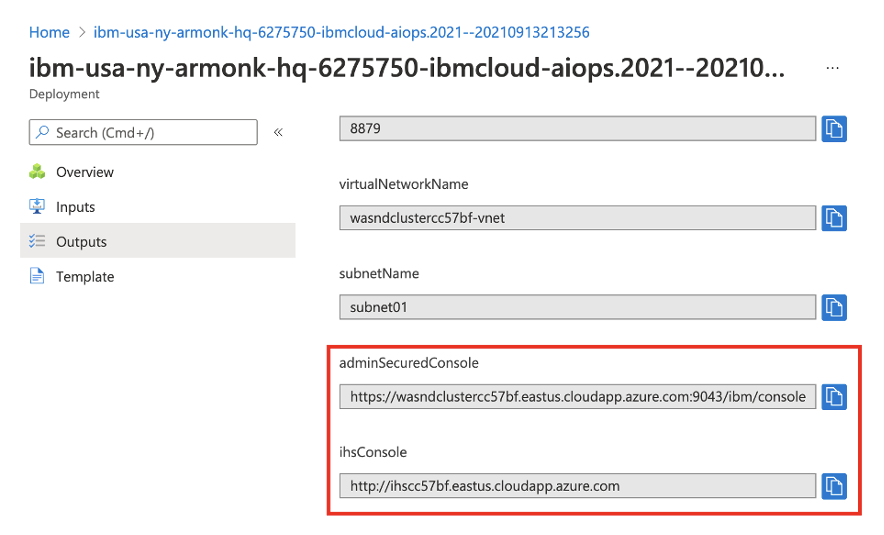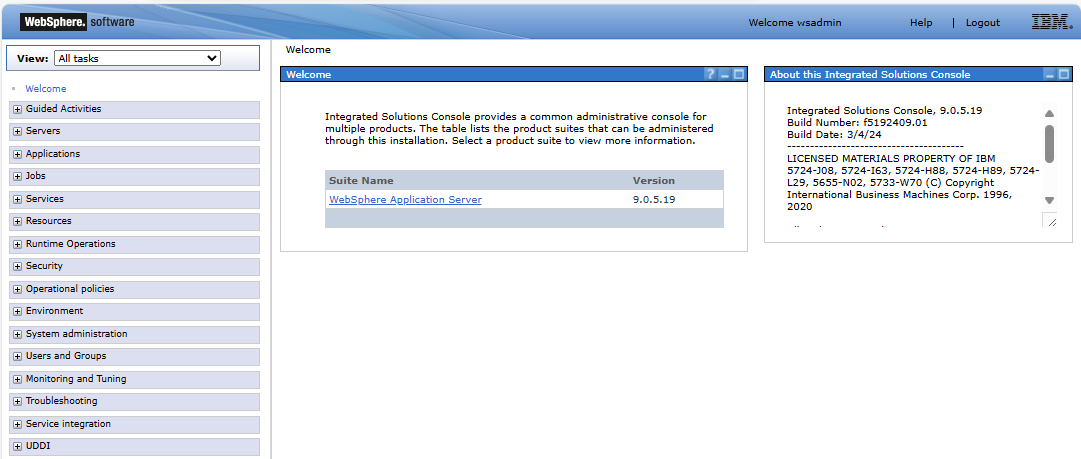Quickstart: Deploy WebSphere Application Server Network Deployment Cluster on Azure Virtual Machines
This article shows you how to quickly deploy a cluster of traditional WebSphere Application Server (tWAS) Network Deployment (ND) instances on Azure Virtual Machines (VMs).
The article uses the Azure Marketplace offer for WebSphere Application Server Cluster to accelerate your journey to Azure VMs. The offer automatically provisions a number of resources including latest Red Hat Enterprise Linux (RHEL) VMs with fixes, latest WebSphere Application Server ND 9.0.5.x on each VM with fixes, latest IBM Java Development Kit (JDK) 8 with fixes on each VM, a Deployment Manager on one of the VMs with Administrative Console enabled, and optionally an IBM HTTP Server (IHS) or Azure Application Gateway as load balancer. Visit Azure portal to see the offer IBM WebSphere Application Server Network Deployment Cluster on Azure VMs.
If you prefer manual step-by-step guidance for installing WebSphere Application Server Cluster that doesn't utilize the automation enabled by the offer, see Tutorial: Manually install IBM WebSphere Application Server Network Deployment traditional on Azure Virtual Machines.
If you're interested in providing feedback or working closely on your migration scenario with the engineering team developing WebSphere on Azure solutions, fill out this short survey on WebSphere migration and include your contact information. The team of program managers, architects, and engineers will promptly get in touch with you to initiate close collaboration.
Prerequisites
- An Azure subscription; if you don't already have an Azure subscription, you can activate your Microsoft Developer Network (MSDN) subscriber benefits or sign up for a free account.
- An IBMid with necessary entitlement for WebSphere Traditional (optional). If you create the deployment with an evaluation license, you don't need to provide an IBMid with entitlement for WebSphere Traditional. To get the benefit, you need to accept the IBM WebSphere Application Server License Agreement during the deployment creation steps. Otherwise, you must enter your registered IBMid and your IBMid must have active WebSphere entitlements associated with it. If provisioning with IBMid fails due to lack of entitlements, ask the primary or secondary contacts for your IBM Passport Advantage site to grant you access. Alternately, follow steps at IBM eCustomer Care for further assistance. This offer assumes you're properly licensed to run offers in Microsoft Azure. For more information, see IBM eCustomer Care.
Deploy a cluster
Start your deployment by going to the Azure Marketplace offer IBM WebSphere Application Server ND Cluster on Azure VMs in the Azure portal. By default, the deployment consists of the following resources:
- One Deployment Manager instance for managing the applications and application servers.
- One IBM HTTP Server instance for managing load balancing.
- WebSphere Application Server instances (nodes) for running your applications (defaults to 3 for High Availability).
The following diagram shows the default configuration.

To start your deployment, select Create on the deployment page.

Then, you're shown the Create IBM WebSphere Application Server Cluster page where you can start configuring the deployment, as shown in the following screenshot.
You need to select the checkbox to accept IBM License Agreement.
Consider selecting the checkbox labeled I agree to IBM contacting my company or organization. Selecting this checkbox indicates that you're willing to let IBM and Microsoft contact you for further offer development.
After you complete this configuration, select Next: Cluster configuration.
The Cluster configuration pane lets you configure the virtual machines and WebSphere Application Server cluster. The latest version of WebSphere is installed along with the most recent fixes to ensure your deployment is up to date.
When you specify the cluster configuration, you have the option of creating a Dynamic Cluster. A Dynamic Cluster is a server cluster that uses weights and workload management to balance the workloads of its cluster members dynamically. The weights are based on performance information collected from the cluster members. For this exercise, keep the default Static Cluster option.
After you complete this configuration, select Next: Load Balancer.
The Load Balancer pane gives you the option to deploy the IBM HTTP Server (IHS) load balancer into its own VM or to deploy Azure Application Gateway. IHS is the web server front end for the cluster of application servers. IHS receives requests and routes them to one of the server instances, enabling you to have more than one instance of the application processing requests. By using IHS, your deployment can scale to higher workloads and be resilient to failures and highly available. Without IHS, you have to set up your own load balancing across your cluster and ensure that it correctly points to the worker nodes.
This article is written to use IHS. However, Azure Application Gateway is a great option for a more cloud-native load-balancing solution. For more information on Azure Application Gateway, see What is Azure Application Gateway?
Complete the configuration for IHS and select Next: Networking. This pane enables you to select the virtual network and subnet into which tWAS and IHS are deployed. Accept the defaults and then select Next: Database.
The Database pane enables you to configure your tWAS deployment with a Java Naming and Directory Interface (JNDI) connection to an existing database, assumed to be network accessible from the VMs for tWAS. Accept the defaults and then select Next: Review + create.
A summary of the deployment appears so you can validate the configuration. Fix any configuration problems, then select Create to start the deployment. You're taken to a page where you can view the progress of the deployment, which usually takes around 20 minutes.
Access the WAS Administrative Console and IHS Console
After the cluster deployment completes, select the Outputs section on the left panel to see the administrative console and IHS console URLs, along with other details.

Use the copy icon to copy these URLs for the WebSphere Integrated Solutions Console and the IBM HTTP Server, then paste them into two different browser address bars to sign in to both consoles, separately. After the administrative console page loads, you should see the sign in page, as shown in the following screenshot.

Sign in using the WebSphere administrator credentials you provided when setting up the Cluster configuration. After signing in, you see the following page.
Then, sign in to the IHS console. After the IHS console loads, you should see the following page:

Trying out an application
Follow these instructions if you'd like to try out an application in the cluster.
On the administrative console that you signed into earlier, select Applications > New Application and then select New Enterprise Application.
On the next panel, select Remote file system and then select Browse…. You're given the option to browse the file systems of your installed servers.
Select the system that begins with Dmgr. You're shown the Deployment Manager's file system. From there, select V9 and then installableApps. In that directory, you should see many applications available to install. Select DefaultApplication.ear and then select OK.
Then, you're taken back to the page for selecting the application, which should look like the following screenshot:

Select Next and then Next to go with the Fast Path deployment process.
In the Fast Path wizard, use the defaults for everything except Step 2: map modules to servers. On that page, select the checkbox for the Default Web Application Module row, then hold Ctrl and select the options under Clusters and servers. Finally, select Apply.
You should see new entries in the table under the Server column. These entries should look similar to the ones in the following screenshot.
After you complete all the steps, select Finish, and then on the next page select Save.
Next, you need to start the application. Go to Applications > All Applications. Select the checkbox for DefaultApplication.ear, ensure the Action is set to Start, and then select Submit Action.
You should see success messages that look similar to the ones in the following screenshot. If you see errors, you were probably too quick, and the app and configuration didn't reach the nodes yet.
When you see the success messages, you can try the app. In your browser, navigate to the IHS deployment and add /snoop. You should see information similar to the following about the server instance that processed the request.

When you refresh the browser, the app cycles through the server instances.
Clean up resources
To avoid Azure charges, you should clean up unnecessary resources. When you no longer need the cluster, use the az group delete command. The following command removes the resource group, VMs, disks, IP addresses, and all related resources.
az group delete --name <deployed-resource-group-name> --yes --no-wait
Next steps
To explore options to run WebSphere products on Azure, see What are solutions to run the WebSphere family of products on Azure?
Feedback
Coming soon: Throughout 2024 we will be phasing out GitHub Issues as the feedback mechanism for content and replacing it with a new feedback system. For more information see: https://aka.ms/ContentUserFeedback.
Submit and view feedback for







